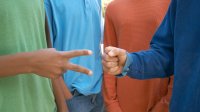Students Can Solve Many of Their Own Problems
Teachers can help students develop independence by encouraging them to work together and to recognize the value of mistakes.
Your content has been saved!
Go to My Saved Content.When I taught elementary school, kids often organized epic kickball games where minor disagreements would inevitably arise. For instance, a common argument was whether a player was safe or out. One side would yell that the player was out, and the other would insist that they were safe. Multiple eyewitnesses would be called upon to give their opinions. As the adult on the sidelines, I was always tempted to step in, but I would hold back, watching the players work through the conflict and get back to the game.
How do we empower kids to handle problems, inside and outside of the classroom? We need to let children handle small issues on their own and make mistakes. It can be tempting as educators to step in the moment we see a child start to struggle, but doing so sends the message that we don’t think kids can handle problems on their own. That can create stress and feelings of self-doubt. A simple solution: step back and let kids flex their independent problem-solving skills.
Building Problem-solving Skills
Would you rather: An easy way to create an environment where students feel safe taking risks is by asking accessible, open-ended questions. In a language class, “would you rather” questions can be great icebreakers. You can use questions like “Would you rather be tiny like an ant or huge like a giant?” In math, you can start class with a similar type of question, like “Which one doesn’t belong: 2, 3, 4, 5?” In a geography class, consider posting pictures of two different locations and asking where the students would rather live and why. These questions don’t have an incorrect answer, which allows students to share their thinking without the risk of being wrong.
The “first three minutes”: I love giving my students challenging problems to wrestle with. To get kids to tackle tough problems independently, I often hand out an assignment and tell them that I won’t answer any questions for the first three minutes of the task. This allows students time to grapple with how to initiate a tough task. (Obviously support and scaffolds are in place for children who require extra help.)
I’ve found that after the initial awkwardness of staring at the problem, kids begin jotting down ideas or drawing pictures, and the wheels start to turn. After the first three minutes, I open up to student questions, often responding with questions of my own, like “Does any part of this problem look similar to one you’ve solved before? If so, can you use a similar strategy this time?”
This helps kids build on previous knowledge and guides them down the road of discovery—without telling them exactly how to get there. If the task doesn’t look like something they’ve done before, I might ask, “What do you know about the problem?” From there, you can help build on the little they do know and give hints along the way.
At the end of a challenging task, we always reflect on the process. I often ask how many of the students felt they could solve the problem during the first three minutes, as well as what strategies or questions helped them determine the answer. I always point out how they solved the problem using their own knowledge, each other, and only a little help from me. I want my students to see how capable they are of taking on challenges and solving them on their own. Knowing that tough problems can be seen as fun challenges shows that it’s OK not to have an immediate answer. Not only can struggle be useful, but also the result can bring a lot of satisfaction and pride.
Reframing right and wrong: When a child makes a mistake, framing it in a positive or humorous light can let them know that mistakes aren’t bad—and that they are key to learning. In my math class, students often ask with anticipation if they had any “oopsies” when I review their work. Oopsies are celebrated in our class, and my students often cheer when I tell them they had a few oopsies they need to clean up. It is a silly way to make mistakes joyful and add humor to the class.
I frequently use the phrase “beautiful mistakes” as a way to examine work that needs correction. Kids get excited to make beautiful mistakes because they are able to share their work and ask their classmates questions about how they would change it. The child with the beautiful mistake feels helpful because they are making their classmates think about a problem in a new way. The helping classmate feels helpful because they are helping someone come to a new answer. Taking time to build a classroom environment where kids feel OK taking academic risks is essential to empowering children.
During those epic games of kickball, the kids would work it out, resolving their conflict with a game of rock-paper-scissors or a redo on the play. I was always amazed at how often the kids came to peaceful, intelligent resolutions without adult intervention.
As teachers, it is somewhat instinctive to jump in and help kids resolve issues, whether they are interpersonal or educational. There are times when the better approach is to listen, watch, and see if kids can resolve small problems on their own. When kids know that they have tools to handle problems, it helps build confidence and prepares them to face more productive struggles down the road.
